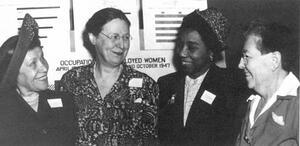Pauline Newman
Institution: The Schlesinger Library, Radcliffe Institute, Harvard University
Pauline Newman was born in Kovno, Lithuania, sometime around 1890, the youngest of four children. Her activist career began with her childhood fight for the right to an education. The Kovno public school excluded her because her family was Jewish and poor, and the Jewish educational system was only for boys. Newman was eventually allowed to attend Sunday school classes, where she learned to read and write Yiddish and Hebrew, but the rabbi would not allow her to study religious texts. She begged her father to let her sit in on the Talmud classes that he taught, and he relented. Newman would later recall her resentment at the privileges given to males in Jewish education and worship as the spark for her lifelong fight against sex discrimination.
When Newman’s father died suddenly in 1901, her family emigrated to New York City. At age nine, Newman went to work in a hairbrush factory. Two years later, she began working among other children in the “kindergarten” at the Triangle Shirtwaist Factory.
Depressed by the grim conditions on the Lower East Side, Newman took solace in the worker-poetry she read in the socialist Yiddish press. She joined the Socialist Literary Society and through reading perfected her English-language skills. Believing that literature would both comfort and radicalize her fellow workers as it did her, Newman organized after-work study groups at the Triangle. These became the basis for the women’s unions she would soon organize.
In 1907, the sixteen-year-old Newman took a group of working women to camp for the summer on the Palisades above the Hudson River. There they planned an assault on the high cost of living. That winter, Newman and her band led a rent strike involving ten thousand families in lower Manhattan. It was the largest rent strike New York City had ever seen, and it catalyzed decades of tenant activism, which eventually led to the establishment of rent control.
At this time, Newman began organizing women garment workers in shops throughout lower Manhattan, paving the way for the “Uprising of the 20,000” strike in 1909. During the long, cold months of the strike, she met with wealthy women, explaining the horrific conditions of the garment industry and winning their sympathy.
In recognition of her key role in organizing and sustaining the strike, Newman was appointed the first woman general organizer for the International Ladies Garment Workers Union. From 1909 to 1913, she toured the United States, organizing garment strikes in Philadelphia, Cleveland, Boston, and Kalamazoo, Michigan. She also stumped for the Socialist Party and campaigned for woman suffrage for the Women’s Trade Union League (WTUL). It was a lonely, frustrating time for Newman, who felt that the union leadership had little interest in organizing women and that her work was undervalued and undermined.
Newman was devastated by the Triangle Shirtwaist Fire of March 25, 1911, in which 146 young workers lost their lives, most of them immigrant Jews and Italians. In 1913, she accepted a post with the Joint Board of Sanitary Control, established by New York State to improve factory safety standards. Newman inspected industrial shops and lobbied state legislatures for wage, hour, and safety legislation for women workers.
In 1917, while working for the WTUL in Philadelphia, Newman met a young Bryn Mawr economics instructor named Frieda Miller. Within the year, the two were living together, beginning a relationship that would last until Miller’s death in 1974. In 1923, the two women moved to New York’s Greenwich Village, where they raised a daughter together. Though lesbian families were not openly discussed in the 1920s, their family seems to have been accepted by government and union colleagues.
In 1923, Newman became educational director for the ILGWU Union Health Center, the first comprehensive medical program created by a union for its members. Newman would retain that position for sixty years, using it to promote worker health care, adult education, and greater visibility for women in the union. She also promoted the cause of women in trade unions through her positions as vice president of the New York and National Women’s Trade Union Leagues. From the late 1920s on, Newman also helped to shape new government agencies charged with the task of improving labor conditions for women workers.
Socially, Newman and Miller were part of the circle of women who surrounded Eleanor Roosevelt in the 1920s and 1930s. They were regular guests at Eleanor’s home and the White House. After World War II, Newman and Miller were sent by the U.S. Departments of State and Labor to investigate postwar factory conditions in Germany. Newman addressed the White House Conference on the Child and served as a regular consultant to the U.S. Public Health Service on matters of child labor and industrial hygiene.
Newman continued to work for the ILGWU until 1983, writing, lecturing, and advising younger women organizers. During her seventy-plus years with the union, she waged a constant struggle to convince male leaders to acknowledge the needs and talents of women workers. As one of the few working-class women of her generation who chronicled the struggles of immigrant working women, Newman also left an important legacy through her writings for newspapers and labor publications.
Pauline Newman died in 1986.
This biography is adapted from Annelise Orleck’s article on Pauline Newman in Jewish Women: A Comprehensive Historical Encyclopedia.



